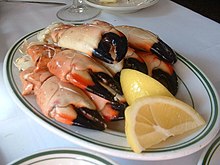Florida stone crab
| Florida stone crab | |
|---|---|
| Scientific classification | |
| Kingdom: | |
| Phylum: | |
| Subphylum: | |
| Class: | |
| Order: | |
| Suborder: | |
| Infraorder: | |
| Superfamily: | |
| Family: | |
| Genus: | |
| Species: | M. mercenaria
|
| Binomial name | |
| Menippe mercenaria (Say, 1818)
| |
The Florida stone crab, Menippe mercenaria, is a crab found in the western North Atlantic, from North Carolina to Belize, including Texas, the Gulf of Mexico, Cuba and the Bahamas that is widely caught for food.
Description
The stone crab's carapace is 3 to 3½ inches (7 to 9 cm) long and about 4 inches (10 cm) wide. They are brownish red with gray spots and a tan underside, and have large and unequally-sized chelae with black tips. In addition to the usual sexual dimorphism exhibited by crabs, the female Florida stone crabs have a larger carapace than males of a similar age, and males generally have larger chelae than females.
Ecology
Florida stone crabs prefer the bottoms of bays, oyster reefs, and rock jetties where they can burrow or find refuge from predators. Juveniles do not usually dig burrows, but instead hide among rocks or in seagrass beds. It is dark brownish-red with gray interspersed. The claws are hinged, very dark, and banded with red and yellow. Adult Florida stone crabs make burrows in mud or sand below the low tide line, lying in wait for prey.
Florida stone crabs prefer to feed on oysters and other small mollusks, polychaete worms, and other crustaceans. They will also occasionally eat seagrass and carrion. Predators that feed on stone crabs include horse conch, grouper, sea turtles, cobia, octopuses, and humans. [1]
Sexual maturity is reached at one year. Their long spawning season lasts all spring and summer, during which time females produce 500,000 to 1 million eggs. The larvae go through six stages in about 36 days before emerging as juvenile crabs. Their lifespan is seven to eight years.
The male Florida stone crab must wait for the female to molt her exoskeleton before they can mate. After mating, the male will stay to help protect the female for several hours to several days. The female will spawn four to six times each season.
The Florida stone crab loses its limbs easily to escape from predators or tight spaces, but their limbs will grow back. When a claw is broken in the right place, the wound will quickly heal itself and very little blood is lost. If, however, the claw is broken in the wrong place, more blood is lost and the crab's chances of survival are much lower. It only takes about one year for the claw to grow back to its normal size. Each time the crab molts, the new claw grows larger.
The larger of the two claws is called the "crusher claw". The smaller claw is called the "pincer claw". If the larger crusher claw is on the right side of the crab's body, the crab is "right handed". If the crusher claw is on the left side of the crab's body, it is "left handed". Since crabs' eyes are on stalks, they can see 360°. A large crab claw can weigh up to half a pound.
Fishery

The Florida stone crab is usually fished near jetties, oyster reefs or other rocky areas, just as for blue crabs. The bodies of these crabs are relatively small and so are not eaten, but the claws (chelae), which are large and strong enough to break an oyster's shell, are considered a delicacy. Harvesting is accomplished by removing one or both claws from the live animal and returning it to the ocean where it can regrow the lost limb(s). To be kept, claws must be 2.75 inches (70 mm) long, measured from the tips of the immovable finger to the first joint. If both claws are legal size they may both be taken, although this is not recommended since it leaves the crab defenseless and unable to acquire food. Florida stone crabs are legal for harvest from October 15 until May 15. [2] During the 1960s, the species was almost exterminated by overfishing, but an eight-year moratorium was imposed and the population was restored.
The popularity of the Florida stone crab has grown again in recent years and is considered to be one of the best varieties to eat.
The claws are prepared in the same manner as blue crab claws.
References
External links
- Florida stone crab information from the South Carolina Department of Natural Resources
- Demonstration of cracking the claw
- Florida stone crab information from Florida
- Harvesting Stone Crabs - Video and article on harvesting stone crab claws in Key West Florida.
- Florida Crabbing and Shrimping Forums - Non Profit Forums dedicated to Crabbing and Shrimping in Florida's waters
